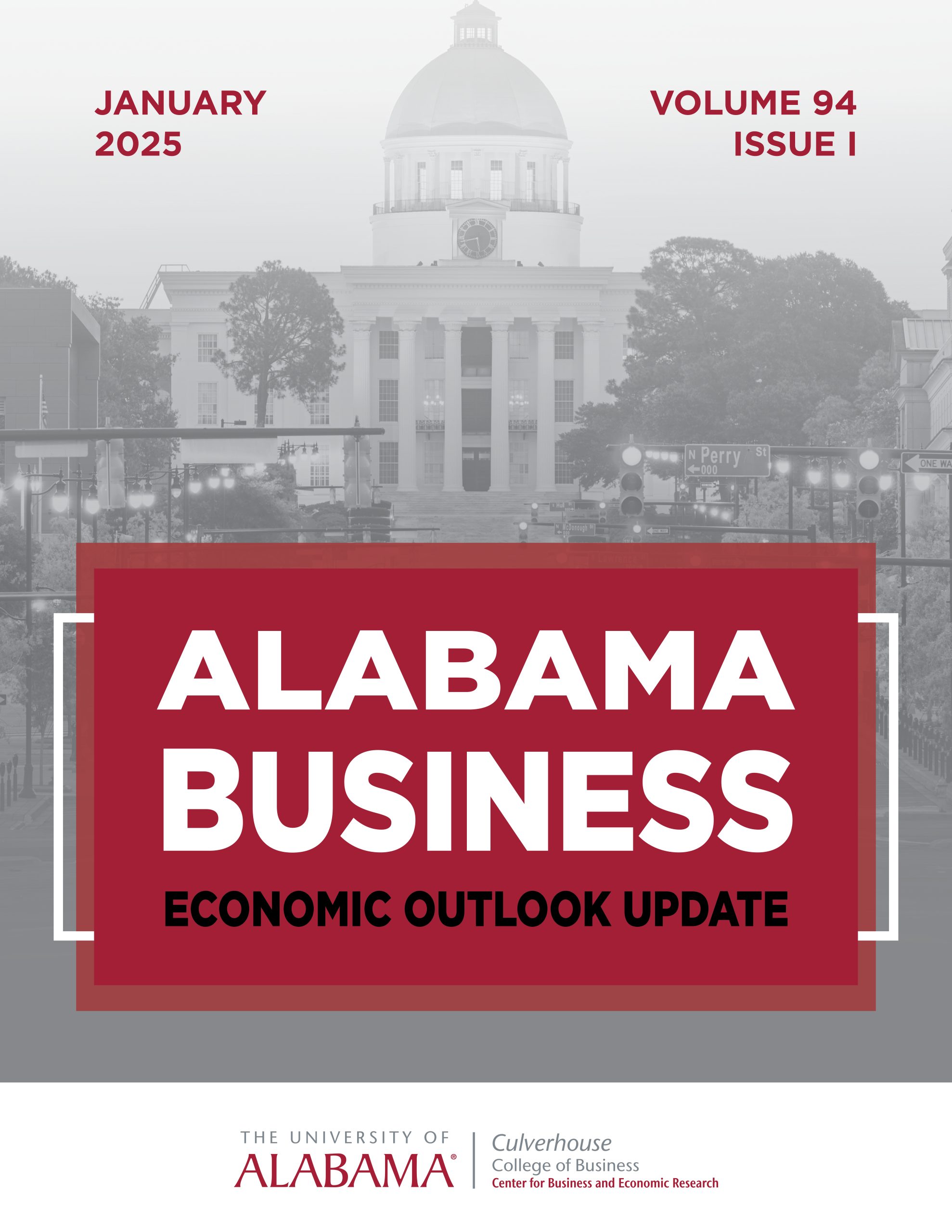Alabama Business™
Established in 1930, each issue contains a free quarterly Alabama economic forecast update.
Economic Outlook Update:
Alabama Business | January 2025
- After showing a slight decline of 0.1 percent in the first quarter 2024, Alabama’s economy, as measured by inflation adjusted Gross Domestic Product (GDP) grew by 3.4 percent and 6.0 percent during second and third quarters respectively, totaling $254.4 billion. For the year economic growth is expected to be around 3.0 percent, followed by an approximate growth of about 2.0 percent in 2025.
- The State gained 1,900 jobs in December over the previous month, bringing the total net gain in jobs to 39,900 from December 2023 to December 2024, while the seasonally adjusted unemployment rate increased from 2.8 percent to 3.3 percent, employment is expected to grow by about 1.7 percent in 2025.
- During the twelve-month period ending in December 2024, seasonally adjusted number of unemployed workers rose from 64,101 to 76,643 and the labor force participation rate went up from 57.4 percent in December 2023 to 57.7 percent in December 2024.
- Year to date, total tax revenues declined by 0.1 percent in December 2024 to approximately $4.2 billion during the first 3 months of the current fiscal year. For the same period sales tax receipts increased by 2.5 percent to about $787 million while individual income tax revenues went down 1.4 percent, totaling approximately $1.6 billion. Total tax revenues are forecasted to increase by about 1.0 percent for the FY2024-2025.
- For the first eleven months of the year, Alabama exports totaled $24.9 billion, down from $25.2 billion for the same period during previous year, a 0.1 percent decline. Transportation equipment remained state’s largest export, declining from approximately $13.5 billion during first eleven months in 2023 to $12.8 billion for the same period in 2024. Canada remained the largest destination for Alabama exports, totaling $3.95 billion for the first eleven months of 2024, compared to $3.7 billion for the same period in 2023, followed by China ($3.93 billion), Germany ($3.87billion) and Mexico ($3.85 billion).
- For the first eleven months of the year, Alabama imports totaled approximately $38.0 billion, up from $34.4 billion for the same period during previous year, a 4.8 percent increase. Imports from Mexico totaled $6.5 billion for the first eleven months of 2024, compared to $7.5 billion for the same period in 2023, followed by South Korea ($5.9 billion), Germany ($4.5 billion) and China ($3.7 billion). Transportation equipment was the largest import (almost $12.9 billion), followed by nonelectrical machinery ($3.23 billion), electrical equipment and appliances ($3.19 billion), and computers and electronic products ($2.7 billion).
- The US economy grew by 2.8 percent in 2024, the growth was primarily due to increases in consumer spending, investments, government spending, and exports. Imports, which are a subtracted from the GDP also increased. Consumer spending increased by 2.8 percent with spending on durable goods rising 3.3 percent. Nonresidential investment spending rose 3.7 percent while residential investment increased by 4.2 percent, following an 8.6 percent and 8.3 percent declines seen in residential investments during previous two years. Exports and imports increased by 3.2 percent and 5.4 percent respectively while government spending rose 3.4 percent.
- U.S. inflation rate, as measured by consumer price index (CPI) rose by an annualized 3.0 percent in 2024, down from 4.1 percent in 2023. Forecast for inflation rate calls for a 2.9 percent increase in 2025.
- The US economy added 256,000 jobs in December while the unemployment rate was 4.1 percent. Most of the job gains in December were seen in healthcare (46,000), adding an average of 57,000 jobs per month in 2024; government (33,000) while adding an average of 37,000 jobs per month in 2023; and social assistance (23,000), also adding an average of 18,000 jobs per month in 2024. Retailers also added about 43,000 jobs in December following job losses totaling 29,000 in November.
- U.S. GDP is forecast to grow by about 2.0 percent in 2025 with consumer spending increasing by 2.5 percent. Overall business spending will increase by about 1.8 percent in 2025, while residential investments are expected to decline slight by about 1.0 percent.

